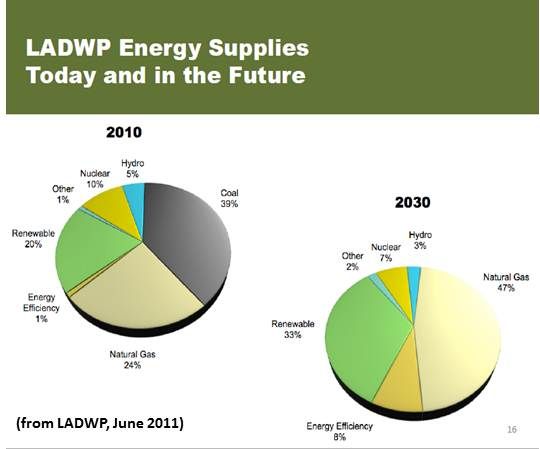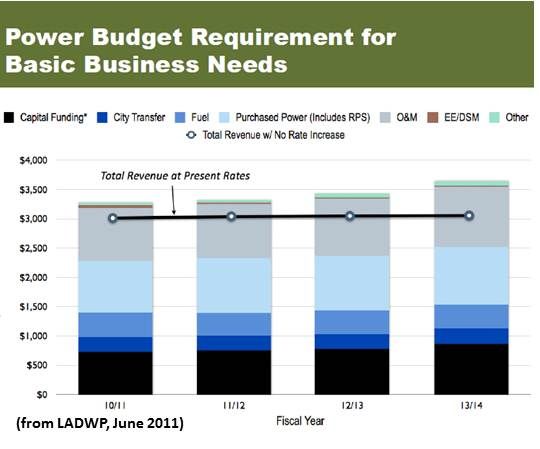California’s 46 publicly owned utilities manage about a quarter of the state’s power. Of them, the Los Angeles Department of Water and Power (LADWP), the state’s (and the nation’s) largest public utility with about nine percent to 12 percent of California’s generation, has been thought the bad boy for making lots of promises about developing renewables and then going back to fossil fuels.
Ron Nichols was brought in as DWP’s manager a year ago to turn that around. The prospect of facilitating change in a utility caught in a web woven by politicians, unions and ratepayers is, Nichols said, “daunting.” Yet, “this is the most exciting time to be providing electric service since Edison invented the light bulb,” Nichols told an audience of greentech stakeholders at the 2012 VerdeXchange.
The transition LADWP must make in order to comply with California’s 33 percent renewables by 2020 mandate -- which was just extended to municipal utilities by Governor Brown this year -- is “a phenomenol opportunity.” With the 33 percent mandate, he said, “We don’t debate this anymore, we just get it done.”
Or do they?

Nichols said he has fought to implement DWP’s mandated elimination of the coal it imports from Arizona and Utah for 40 percent of its electricity -- a process he describes as making him feel “like I have a target on my back.” Still, the utility will make it happen, he said, “as quickly as we can.”
Of the utility’s mandate to implement 10 percent Energy Efficiency (EE) by 2020, Nichols said, “we welcome the opportunity,” though he then went on to note that DWP recently reduced its 2020 EE target to 8.5 percent.
Every year through 2029, Nichols said, the utility must close and replace or retrofit a conventional coastal power plant to eliminate the use of ocean water for cooling. That will cost $2.2 billion.
“On top of that, we have very specific state and local solar mandates,” he added. “Every one of these, individually, would be an interesting challenge. Collectively, it’s a lot.”
Those, and other mandates, Nichols explained, constitute the obligations DWP must meet in order to comply with AB 32, California’s landmark climate change law. “If we meet those obligations,” Nichols began, and then interrupted himself to say it is his job “to see that we do.”
Returning to the EE target reduction from 10 to 8.5 percent, Nichols said DWP’s board “took about as big a step as they think they can take right now.” It’s inadequate, and he's "not satisfied, but every time we haven’t had sufficient rates in our budget, the first thing that we cut is energy efficiency. We do it because we have so few degrees of freedom,” he said.
Of the latest budget, he said determinedly, “We are going to spend $1.25 billion per year between now and 2020 to get there. We should be spending more, we should be getting more, and I hope that we do.”

Nichols produced a graph of, he said, “how we’re going to get to 33 percent by 2020.” It projected growth in wind, biogas, solar (“a major piece of what we’re doing”) and geothermal.
“But the reality is, every one of these requires dozens and dozens of contracts and commitments to projects that make our life a lot less predictable,” Nichols said. “Replacing 1,600 megawatts of coal, replacing a couple of plants with dozens of other actions,” he explained, is not easy. Plus, “there’s a lot of different pieces to solar,” he added, mentioning California’s many programs and incentives. “I’m not complaining about it; it’s just a reality.”
LADWP will replace its coal with renewables, EE and natural gas, Nichols said. “And let’s be clear: we’re going to go to about 47 percent natural gas,” he said, but “if we didn’t have renewable energy, we would be at over 80 percent natural gas.”
The transition will have other costs, as well, he warned. “We’re spending $800 million per year -- the biggest capital investment we’re going to make in the next decade -- replacing aged infrastructure that we should have been replacing years ago. We’re playing catch-up.”

“I’m not going to sit here right now and say exactly what our future rates are going to be, but if everything went fantastically,” he said, “we’d be at about a 4.5 percent per year rate increase for the rest of this decade. Do I think that’s likely? No, I don’t.” A more likely average rate increase, Nichols said, is 6.5 percent per year.
“Is that something we can’t sustain? I don’t think so. I think we can live within this,” Nichols said. “No one wants to see rates go up, but we will be cheaper than our neighbors.” And, he said, “if we do it right, we can provide jobs to our local economy.”
He added two thoughts in conclusion. First, “I hope I can get everyone’s support.” Second, the state has to be very careful about “anything more from a mandate perspective that gets layered on,” because “we have a lot on our plate -- and I hope we can digest it.”



